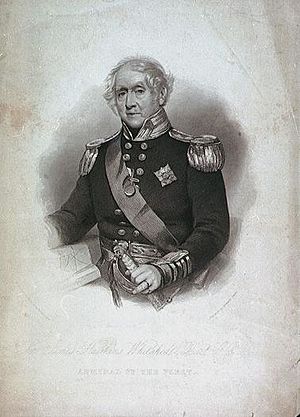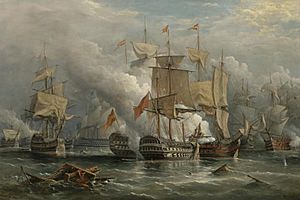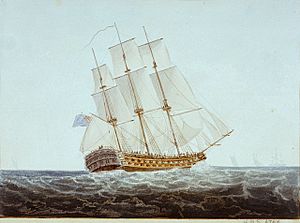James Hawkins-Whitshed facts for kids
Quick facts for kids
Sir James Hawkins-Whitshed, Bt.
|
|
|---|---|

Sir James Hawkins-Whitshed, c.1820
|
|
| Birth name | James Hawkins |
| Born | 1762 Raphoe, County Donegal, Ulster, Ireland |
| Died | 28 October 1849 (aged 86–87) London, England |
| Allegiance | |
| Service/ |
|
| Years of service | 1775 – 1824 |
| Rank | Admiral of the Fleet |
| Commands held |
|
| Battles/wars | American Revolutionary War French Revolutionary Wars Napoleonic Wars |
| Awards | Knight Grand Cross of the Order of the Bath |
Admiral of the Fleet Sir James Hawkins-Whitshed, 1st Baronet (1762 – 28 October 1849) was a brave officer in the Royal Navy. He fought in many important battles. These included the Battle of Martinique during the American Revolutionary War.
Later, he served under Sir John Jervis. He took part in the famous Battle of Cape St. Vincent. This battle happened during the French Revolutionary Wars. After becoming a high-ranking officer, Hawkins-Whitshed led naval forces in Ireland. He was also in charge of the Cork Station during the Napoleonic Wars. After the war ended, he became the Commander-in-Chief at Portsmouth, a major naval base.
Contents
James Hawkins was born in 1762 in Raphoe, County Donegal, Ireland. He was the third son of Dr. James Hawkins, who was a bishop. James started his naval career very young. His name appeared on ship lists when he was just 11 or 12 years old. This was a common practice for future officers back then.
His first real time at sea was in 1775. He served on the ship HMS Aldborough. He sailed to Newfoundland with Captain William Bennett. After this, he served on other ships. He even became a lieutenant in 1778.
Fighting in the American War
In May 1776, James Hawkins was on the frigate HMS Diamond. This ship helped escort troops to America. He later served on the 90-gun ship HMS Sandwich. This was the main ship of Admiral Sir George Rodney.
Hawkins took part in two important actions in January 1780. First, he helped capture a convoy of ships. Then, he fought in the "Moonlight Battle". In this battle, Admiral Rodney defeated a Spanish fleet.
On 10 February 1780, Hawkins was promoted to commander. He was given command of the 14-gun sloop HMS St Vincent. He sailed with Admiral Rodney to the West Indies. He fought again in the Battle of Martinique on 17 April 1780.
The very next day, he was promoted again to captain. He took command of the 20-gun frigate HMS Deal Castle. In October 1780, a huge storm, known as the "Great Hurricane", hit the island of Saint Lucia. Deal Castle was wrecked on the coast of Puerto Rico. Most of the crew survived, but they were captured by the Spanish. After two months, they were released. Hawkins then returned to England.
In July 1781, Hawkins was given command of the new ship HMS Ceres. This ship carried Sir Guy Carleton, a new commander, to America. Ceres stayed in America until 1783. After returning to England, Hawkins took a break from sea. He studied astronomy at the University of Oxford and traveled around Europe.
In 1791, James Hawkins added "Whitshed" to his name. This was to inherit properties from his cousin. He then became James Hawkins-Whitshed. In December 1791, he married Sophia Henrietta Bentinck.
Battles in the French Wars

When war with France began in 1793, Hawkins-Whitshed returned to duty. He commanded the 74-gun ship HMS Arrogant. In 1795, he moved to the 90-gun ship HMS Namur. He sailed to the Mediterranean Sea to join Sir John Jervis.
On 14 February 1797, Hawkins-Whitshed fought in the Battle of Cape St. Vincent. This was a big victory for the British fleet against the Spanish. For his bravery, he received thanks from Parliament and a special gold medal.

In 1798, he commanded the 80-gun ship HMS Ajax. Six months later, he moved to the 98-gun HMS Formidable. He stayed on this ship even after he was promoted to rear admiral in 1799.
In March 1799, Hawkins-Whitshed became even more important. He took command of the 110-gun ship HMS Queen Charlotte. He sailed to the Mediterranean. He later returned to England and joined the Channel Fleet. He stayed there until a temporary peace treaty was signed in 1802.
When fighting started again in 1803, Hawkins-Whitshed was put in charge of the Sea Fencibles in Ireland. These were coastal defense forces. He was promoted to vice admiral in 1804. He also attended the funeral of the famous Lord Nelson in 1806.
From 1807 to 1810, he was the Commander-in-Chief at the Cork Station. He was promoted to admiral in 1810. In 1815, he was made a Knight Commander of the Order of the Bath (KCB). This was a very high honor.
From 1821 to 1824, he served as Commander-in-Chief, Portsmouth. This was a very important role in the Royal Navy. In 1830, he received an even higher honor, becoming a Knight Grand Cross of the Order of the Bath (GCB).
On 1 May 1834, he was given the title of baronet. This meant he became "Sir James Hawkins-Whitshed, 1st Baronet." This title could be passed down to his sons. On 8 January 1844, he reached the highest rank in the navy: Admiral of the Fleet. Sir James Hawkins-Whitshed passed away in London on 28 October 1849.
Family Life
Sir James Hawkins-Whitshed and his wife, Sophia, had two sons and four daughters. Their oldest son, James, also joined the Royal Navy. Sadly, he was killed in 1813 while serving as a midshipman. Their second son, St. Vincent Keene Hawkins-Whitshed, inherited his father's baronet title.
See also
- Hawkins-Whitshed baronets
- Elizabeth Hawkins-Whitshed
|

